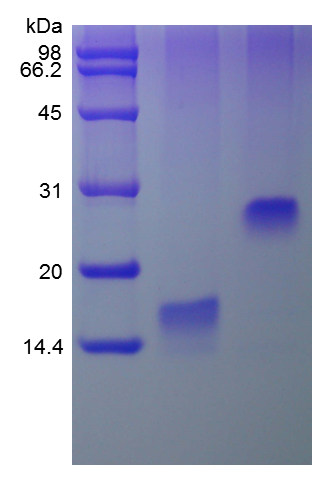- Synonyms
- Intestinal Trefoil Factor, hITF, Polypeptide P1.B, hP1.B
- Source
- Escherichia coli.
- Molecular Weight
- Approximately 13.2 kDa, a homodimeric protein consisting of two 59 amino acid chains, which includes a 40-amino acid trefoil motif containing three conserved intramolecular disulfide bonds.
- AA Sequence
- EEYVGLSANQ CAVPAKDRVD CGYPHVTPKE CNNRGCCFDS RIPGVPWCFK PLQEAECTF
- Purity
- > 97 % by SDS-PAGE and HPLC analyses.
- Biological Activity
- Fully biologically active when compared to standard. The ED50 as determined by a chemotaxis bioassay using human MCF-7 cells is less than 10 μg/ml, corresponding to a specific activity of > 100 IU/mg.
- Physical Appearance
- Sterile Filtered White lyophilized (freeze-dried) powder.
- Formulation
- Lyophilized from a 0.2 µm filtered concentrated solution in PBS, pH 7.4.
- Endotoxin
- Less than 1 EU/μg of rHuTFF3 as determined by LAL method.
- Reconstitution
- We recommend that this vial be briefly centrifuged prior to opening to bring the contents to the bottom. Reconstitute in sterile distilled water or aqueous buffer containing 0.1 % BSA to a concentration of 0.1-1.0 mg/mL. Stock solutions should be apportioned into working aliquots and stored at ≤ -20 °C. Further dilutions should be made in appropriate buffered solutions.
- Stability & Storage
- Use a manual defrost freezer and avoid repeated freeze-thaw cycles.
- 12 months from date of receipt, -20 to -70 °C as supplied.
- 1 month, 2 to 8 °C under sterile conditions after reconstitution.
- 3 months, -20 to -70 °C under sterile conditions after reconstitution.
- Usage
- This material is offered by Shanghai PrimeGene Bio-Tech for research, laboratory or further evaluation purposes. NOT FOR HUMAN USE.
- SDS-PAGE

- Reference
- 1. Seib T, Blin N, Hilgert K, et al. 1997. Genomics, 40: 200-2.
2. Kirikoshi HandKatoh M. 2002. Int J Oncol, 21: 655-9.
3. Lu R, Wang X, Chen JP, et al. 2010. Sichuan Da Xue Xue Bao Yi Xue Ban, 41: 114-7.
4. Jagla W, Wiede A, Dietzmann K, et al. 2000. FASEB J, 14: 1126-31.
5. Takano TandYamada H. 2009. Endocr J, 56: 9-16.
- Background
- Trefoil factor 3 encoded by the TFF3 gene in humans, belongs to the trefoil factor family that consists of three members named TFF1, TFF2 and TFF3. They are characterized by having at least one copy of the trefoil motif, a 40-amino acid domain that contains three conserved disulfides. TFF-3 is expressed by goblet cells and in the uterus, and has also been shown to express in certain cancers, including colorectal, hepatocellular, and in biliary tumors. It involves in the maintenance and repair of the intestinal mucosa, also promotes the mobility of epithelial cells in healing processes. TFF3 overexpression is crucial for progression in mouse and human hepatocellular carcinogenesis. TFF3 may be useful as a molecular marker for certain types of cancer, but its role, if any, in tumorigenesis is unknown.

 COA申请
COA申请
